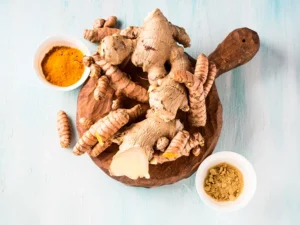Ayurvedic Approaches to Managing Cervical Spondylosis

Ayurveda, an ancient Indian system of medicine, offers various natural remedies an help manage cervical pain caused by spondylosis.
Why does it happen?
Cervical spondylosis is a degenerative condition that develops as a result of wear and tear on the cervical spine over time. As we age, the discs between the vertebrae in the neck lose moisture and elasticity, becoming less flexible and more susceptible to damage. This can lead to the development of bone spurs, which can put pressure on the spinal cord and nerve roots, causing pain and other symptoms.
Other factors that can contribute to the development of cervical spondylosis include:
1. Poor posture:

Regularly holding the head in a forward position, such as when using a computer or reading, can strain the neck and contribute to the development of cervical spondylosis.
2. Repetitive motions:

Repetitive movements, such as those used in certain occupations or hobbies, can put stress on the cervical spine and contribute to wear and tear.
3. Genetics:

There may be a genetic predisposition to developing cervical spondylosis.
4. Injuries:

Injuries to the neck, such as whiplash from a car accident, can damage the cervical spine and contribute to the development of cervical spondylosis.
5. Smoking:

Smoking can accelerate the degenerative process of the cervical spine and increase the risk of developing cervical spondylosis.
Cervical Spondylosis Causes
Cervical spondylosis is a degenerative condition that affects the cervical spine, which is made up of the seven vertebrae in the neck. The following are some of the most common causes of cervical spondylosis:
1. Age:
As we age, the discs between the vertebrae in the neck can become less hydrated and less elastic, which can lead to the development of cervical spondylosis.
2. Wear and Tear:
Overuse, repetitive motions, and poor posture can all contribute to wear and tear on the cervical spine, leading to cervical spondylosis.
3. Occupation:
Certain jobs that require prolonged periods of sitting or standing in one position, such as computer work or driving, can contribute to the development of cervical spondylosis.
4. Weight:

Being overweight or obese can put extra pressure on the cervical spine and increase the risk of developing cervical spondylosis.
Here are some Ayurvedic tips for managing cervical spondylosis:
-
Ayurvedic Massage:

Ayurvedic massage, also known as Abhyanga, can help reduce pain and stiffness in the neck. Warm herbal oils such as sesame or coconut oil are used for the massage, which helps to nourish and lubricate the joints.
-
Yoga:

Gentle yoga poses can help relieve pain and improve flexibility in the neck. Some beneficial yoga poses for cervical spondylosis include neck stretches, shoulder rolls, and spinal twists.
-
Diet:

A balanced and healthy diet is essential for overall health and well-being. Ayurveda recommends a diet rich in fruits, vegetables, and whole grains. Avoiding processed foods and foods high in saturated fats and sugar is also recommended.

Ayurvedic herbs such as Ashwagandha, Guggulu, and Shatavari have anti-inflammatory properties and can help reduce pain and inflammation in the neck.
-
Lifestyle Changes:
Ayurveda emphasizes the importance of maintaining a healthy lifestyle to prevent and manage diseases. Getting enough sleep, practicing stress-management techniques such as meditation, and avoiding smoking and excessive alcohol consumption can all help reduce inflammation and pain in the neck.




One Comment